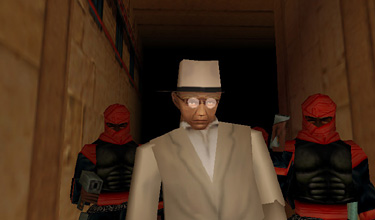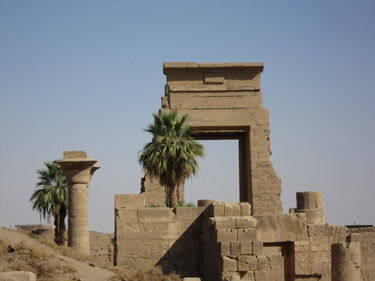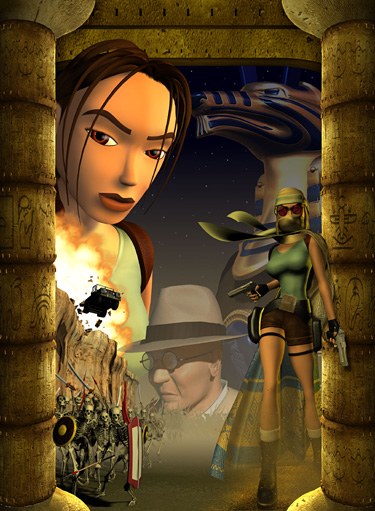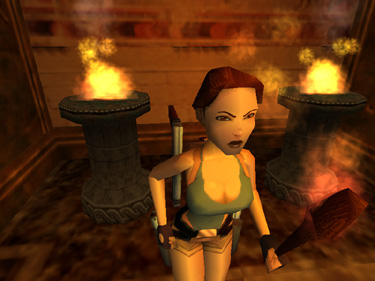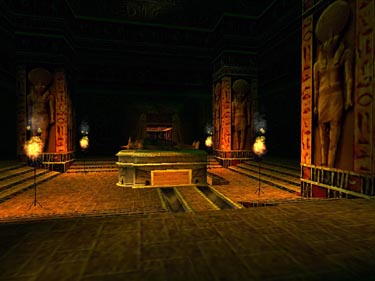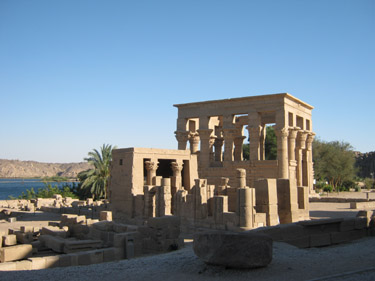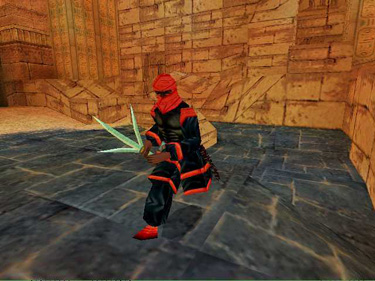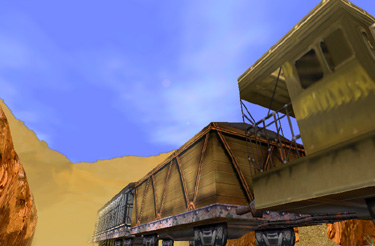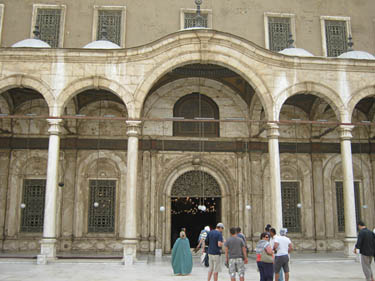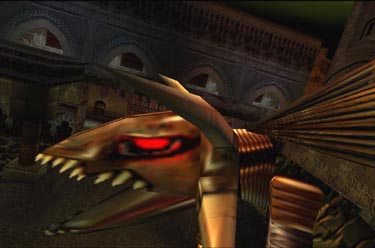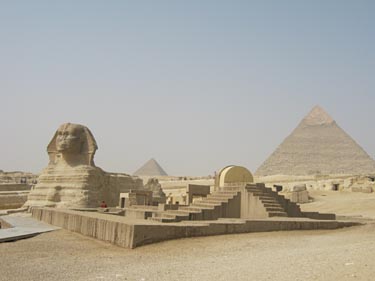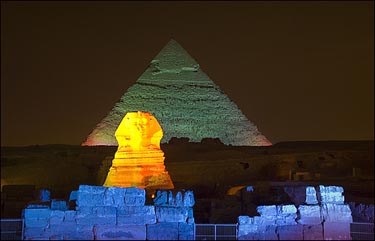Mary Goodden, who writes Well-Rendered, one of my favorite video gaming blogs, spent three weeks this spring traveling in Egypt. She visited a number of Lara's old haunts and returned with stories and photos to share.

Mary GooddenDoes anyone even remember 1999? As in: "I'm gonna party like it's..."?
Well I do. And to me, partying in 1999 consisted of closing the curtains, firing up the PlayStation, preparing a bowl of Cheerios and racing Werner VonCroy across Egypt to prevent the apocalypse. If you're reading this, there's a good chance you were doing the same thing.
Eleven years after the release of Tomb Raider: The Last Revelation, I decided to visit Egypt for the first time. Was The Last Revelation a deciding factor in my choice of holiday destination? Not really. The Egyptian monuments do not need to be viewed through a pop-cultural prism in order to reinforce their majesty. But it is testament to the enduring power of The Last Revelation that I couldn't help but have Lara wandering around in the back of my mind as I explored the Temple of Karnak.
Video game levels are haunting places, apt to stay with you far longer than film sets because unlike film sets, they are not merely the backdrop to the action. Instead, video game environments are the action. This is especially true of the Tomb Raider games because not only is Lara always alone, but her physical interactions with her environment are unmatched by almost any other game.
Consequently, besides the awe I am sure every tourist/explorer/ archaeologist has felt upon first seeing Egypt's monuments, I also felt a quiet appreciation for those level designers who no doubt walked around these same sites with a camera and a notepad, thinking "what if...?"
Of course the environments in the game are different from the real life monuments. That goes without saying. Amongst other things, the game lacks tourists, ticket touts and souvenir salesmen. But then gamers do not want video games to mimic reality. We play video games in order to become somebody else and immerse ourselves in another world. If we wanted to interact with a world that was just like our own, we could just, you know, go outside.
Tomb Raider: The Last Revelation gives players (along with one of the best gaming experiences of the 1990s) a vast, deep and unique interpretation of a country, its landscape and its mythology. It's an experience that no book or film could ever hope to replicate, and it deserves our attention. Again.
* * *
Initially, this article was going to be light on pictures and heavy on analysis. But then I discovered that there really aren't many direct comparisons between Tomb Raider environments and the locations that inspired them, so perhaps it would be interesting to put screenshots of the game environments next to photographs of the real-life monuments.
Before I start, I must apologise in advance for the gaps in this travelogue. I did not manage to go to Cambodia, or visit Alexandria. If anyone would like to fill in these gaps, that would make top-notch reading.
I've tried to arrange the screenshots in the same order that they appear in the game, but due to the back-and-forth structure of The Last Revelation, you might have seen these environments in a different order. Anyway, without further ado, here is an Egyptian travelogue, Tomb Raider style....
[Read More - LINK WILL GO HERE]
In case you've forgotten, The Last Revelation concerns Lara Croft's attempts to avert the apocalypse when a routine tomb raiding expedition goes awry. After removing the ankh-shaped Amulet of Horus from a grizzly sarcophagus, she discovers that in doing so she has unleashed Seth (bringer of plagues etc). Oops!
In "real life", Seth was a God rather than a Pharaoh, so he doesn't actually have a tomb at the Valley of the Kings. Given the disastrous consequences of Lara's expedition, this is probably a good thing. He is, however remembered in many temples throughout the Nile Valley, most notably at Naquada.
His animosity towards Horus—pivotal to the plot of The Last Revelation—is largely down to his admiration for Horus' mother Isis. Due to his infatuation, he killed Isis' husband Osiris, dismembered him and distributed the pieces throughout the Nile Valley. Isis managed to find all the bits and resurrect her beloved Osiris just long enough to conceive a son, Horus.
This episode is remembered all over Egypt, but especially in Philae temple, where Isis is found the final piece of Osiris' body.
The Temple of Philae was initially built several miles south of its current site. However, the construction of the Aswan Dam meant that the Temple was soon submerged beneath Lake Nasser, the largest artificial lake in the world. It was moved, brick by painstakingly numbered brick, to an artificial island on the other side of the dam. That said, Lara wouldn't have much trouble exploring underwater ruins.
About 200km north of Philae temple is the Valley of the Kings, where Lara emerges after removing the amulet.
Sadly, the fragile paintings inside the tombs at the Valley of the Kings are light-sensitive. This means that tourists are not allowed to take a camera inside the complex. If you're interested (of course you're interested!) there are lots of pictures of the various tombs on the internet. I was able to take pictures of the limestone hills from which the tombs are carved. These spectacular natural monoliths form the surrounding landscape, and are beautifully recreated in the "KV5" level in The Last Revelation.
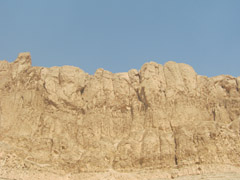 |
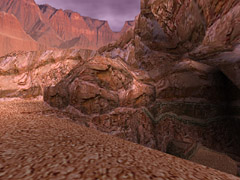 |
| The real Valley of the Kings and the KV5 level in Tomb Raider 4. | |
A lot of the outdoor levels in The Last Revelation have dark, moody lighting and ominously cloudy skies. This works well for two reasons. Firstly, the apocalypse is a serious business, and too much sunshine might encourage the player to kick back and crack open a beer rather than concentrate on the job at hand. Secondly, the alternative would be to set all the levels in the same bright sunshine which shines daily in Egypt. Nice though this is in real life, it would become monotonous in a game, so the developers wisely used their artistic licence and cast those inscrutable clouds over The Valley of the Kings.
Aside from the weather, The Last Revelation's Valley of the Kings looks much like it does in real life. Just down the road is Hatshepsut's mortuary temple complex, Deir el-Bahri, situated in a natural limestone auditorium similar to the Valley of the Kings. I couldn't speculate as to whether this temple directly influenced the Valley of the Kings and the KV5 areas of The Last Revelation, but its proximity makes this likely.
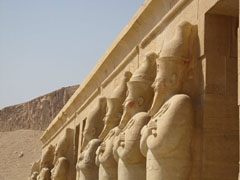 |
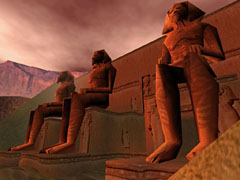 |
| Statues at Deir el-Bahri and another KV5 screenshot from the Last Revelation. | |
The Valley of the Kings is the burial site for many of the New Kingdom Pharaohs, including Tutankhamun. Hatshepsut was a woman, and one of the most successful Pharaohs ever to rule Egypt. Had Lara not accidentally hastened Doomsday, she might have found the time to pop in.
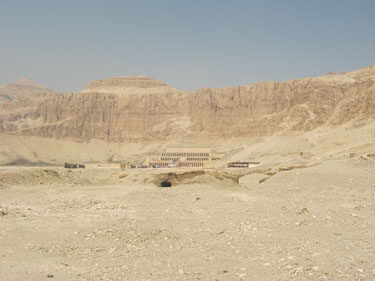 Deir el-Bahri is a complex of mortuary temples and tombs located on the west bank of the Nile, opposite the city of Luxor. |
In 1997 Deir el-Bahri was the site of a terrorist massacre in which 58 tourists were killed. This (alongside several subsequent attacks over the last decade) is one of the reasons a modern tourist's Egyptian experience is so different from Lara's. The importance of tourism to the Egyptian economy means that tourists must now be protected at all costs, meaning that heavily armed tourist police now patrol every major (and minor) site. It's also necessary to run your bag through a metal detector every time you enter a major building, though tourists generally are usually waved through regardless. That said, perhaps the fact that Lara's bag contains a shotgun, a crossbow, a grenade launcher, a revolver, a pair of uzis, a pair of pistols and a large volume of explosives might have slowed her down a little at this point.
After Lara's frantic Jeep ride through the Valley of the Kings, she leaps onto a rusty Nile ferry and continues to the home of her friend Jean-Yves. Interestingly, Jean-Yves is based on the real-life Egyptologist Jean-Yves Empereur, who is almost exactly like the Tomb Raider character. However, real-life Jean-Yves wasn't happy about popping up in The Last Revelation, so I won't put a picture of him in here. He was later replaced by the similar (albeit British) character Charles Kane in Chronicles.
Given that The Valley of the Kings is but a few miles from Karnak, and Jean-Yves' house appears to be between the two, it is likely that he lives in the nearby city of Luxor. Today, Luxor is mainly used as a base for anyone visiting the wealth of surrounding monuments, and consequently it is filled with places to eat and shop. Sadly, Lara doesn't have time to pick up a T-shirt.
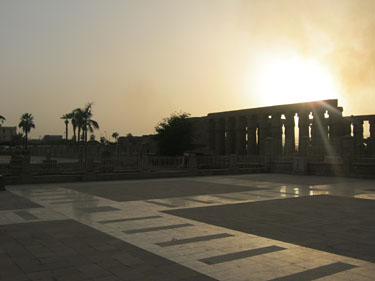 The city of Luxor, Egypt. |
Anyway, Jean-Yves tells Lara that she needs to travel to Karnak to visit the Tomb of Semerkhet in order to find out how to re-entomb Seth. Before that, however, she has to make her way through the Temple of Karnak itself.
The Karnak complex in real life is truly awe-inspiring. I completely understand why those guys at Core had gone to such pains to recreate it. Of all the environments in The Last Revelation, the Karnak levels are the ones which most resemble their original counterparts.
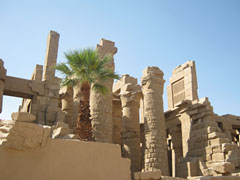 |
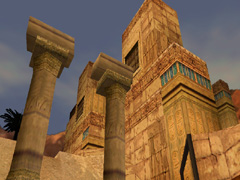 |
| Karnak in real life and Last Revelation style. | |
The Temple complex is vast, and tourists are able to explore it freely. Through every archway is another relief, every relief leads to another statue. It doesn't take much to imagine vaulting onto a ledge and through a crawlspace in order to find a Canopic jar. The crumbling stones have lost none of their majesty. It's really hard to do anything other than gush.
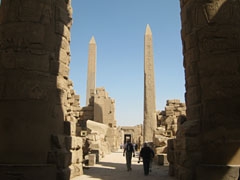 |
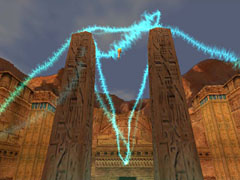 |
| A little blue lightning helps distinguish the obelisks in the game from the real thing. | |
The Great Hypostyle Hall is astonishing. Interestingly, Egyptologists still don't really know how the vast pillars were a) made and b) erected. A popular theory is that the granite pillars were cut straight out of the rock using wood wedges that were soaked in water to expand them, thus easing the pillars out of the ground. Once carved, many scholars believe that they were transported to the site on their sides and then manoeuvred upright using piles of sand. The people at the bottom give you a good idea of the scale.
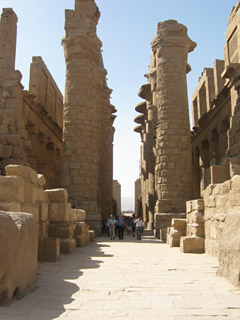 |
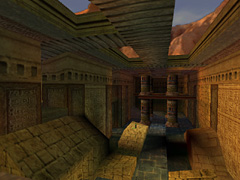 The Great Hypostyle Hall today and as it appears in The Last Revelation. |
Originally, every surface of the temple was painted in opulent colours. We know this because the few surfaces of the temple which are not exposed to the elements still retain a little colour. In The Last Revelation, the entire Hypostle Hall appears to have retained its paint job.
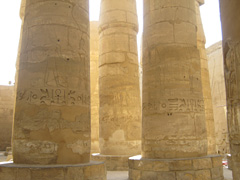 |
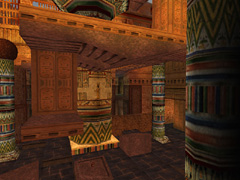 |
The Sacred Lake at Karnak is also shrouded in mystery. Astonishingly, no-one is really sure how deep it is due to the unevenness of the bottom and the opacity of the water.
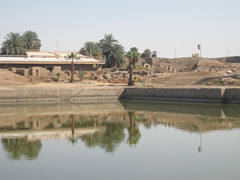 |
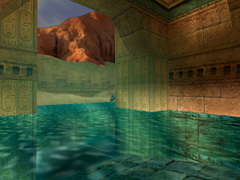 |
In The Last Revelation, Lara had to fight crocodiles in crystalline water. Again, I reckon this was a good call on the part of the developers, since there has never been a good game about recovering from a water-borne illness.
Needless to say, The Last Revelation does not recreate Karnak. It takes its colours, its shapes and its history and imagines a place untouched by commerce and tourism. Before we get too wistful, it's best to remember that Lara's Karnak is also beset by scorpions and assassins, so contemporary Egypt is not all that bad.
After this, Lara undergoes a rather gruelling session in the Tomb of Semerkhet, which I didn't visit (it's down the road in Abydos, if you're interested). Emerging into the light, she accosts her former guide, disguises herself in his robes, and boards the desert train to Alexandria.
Now, I didn't make it to Alexandria, but I did get a desert train from Luxor (the city near Karnak and Abydos). Was it like the train in The Last Revelation? Well, no. But there is a good reason for this. You see, security precautions in Egypt since the recent attacks dictate that tourists are only allowed to board the "deluxe" sleeper trains north from Luxor. Consequently, it is entirely possible that Lara (in her very convincing disguise) may have boarded the kind of freight train which tourists are forbidden to ride.
Sadly, I don't have a picture of the sleeper carriage in which I rode. But I do have the picture of the breakfast I received.
I tell you, there is no more nutritious start to the day than six cakes.
Following her ninja-dispatching antics aboard the desert railroad, Lara winds up in Alexandria to ask Jean-Yves for more advice and to explore the coastal ruins. Sadly, I didn't follow her there. That said, it seems a shame to neglect the Alexandria levels altogether, so I will mention Egypt's coastline, which I was able to visit.
Although many of Egypt's visitors come for the monuments, a good proportion return for the diving. The north (Mediterranean) coast, the east (Red Sea) coast and the Sinai peninsula are rich with both sea life and sunken treasures. Remains of the Pharos lighthouse were found underwater in 1994 (just in time for Lara), and the wreck of the SS Thistlegorm was found by Jacques Cousteau in the early '50s. The water is as astonishingly clear and blue as it is in the game.
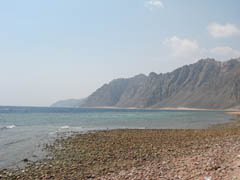 |
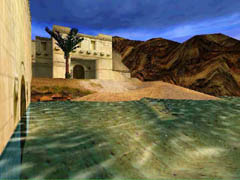 |
| Egypt's Red Sea coast and the Coastal Ruins level in Tomb Raider 4. | |
Following the saturation of light and colour of the Alexandria levels, The Last Revelation takes an altogether gloomier turn as Lara arrives in Cairo in order to save Jean-Yves from Werner. This section of the game takes place in the old Islamic quarter of Cairo, partly in the Citadel of Salah Al-Din. Being a site of historical interest (and tourist revenue), the Citadel is managed by the Supreme Council of Antiquities who are responsible for all the archeological sites and artifacts within Egypt.
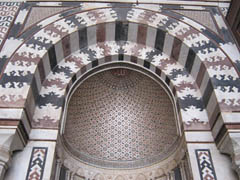 |
 |
| Cairo's Citadel of Salah Al-Din. | |
When she arrives in Cairo, the police aren't too friendly. Although their reaction is a little extreme, Lara probably isn't helping matters by being quite so scantily-clad. Although bare arms, shoulders and legs are tolerated in the larger tourist sites such as Giza, women can expect attention around the city if they don't make an effort to cover up. In the Mosque of Muhammad Ali, women who aren't sufficiently covered are given an attractive green cape to wear.
The darkness of the Cairo levels can partly (and, well, logically) be attributed to the fact that they are set at night. However, pollution might also have something to do with it. Cairo is one of the most densely populated cites in the world, and has one the smallest ratios of green spaces to people. Although Cairo is most certainly not gloomy—it's busy, diverse and exciting—it is a little grubby. Sand blown in from the desert doesn't help. Islamic Cairo's stately minarets rise majestically over the vast cloud of car fumes and dust which enshroud the city.
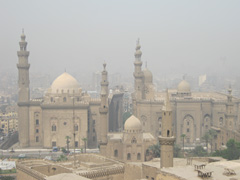 |
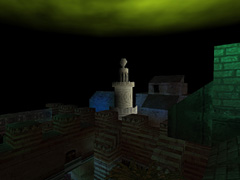 |
| Cairo's skyline includes modern buildings and towering minarets. | |
The famous Khan El Khalili street bazaar is reimagined in The Last Revelation as an altogether murkier destination.
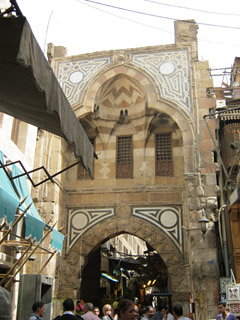 |
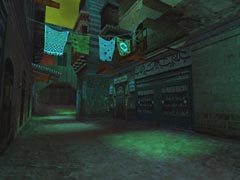 A bustling street bazaar in Cairo... and the far more sinister game setting. |
If Lara had managed to make her way to the bazaar without awakening Seth, her biggest irritation would have been enthusiastic salesmen trying to sell her trinkets. As it is, her actions lead to the presence of a beast in the streets of the city. Perhaps this is the reason for the bazaar's dilapidation.
Once she's rescued Jean-Yves, there's only one thing left for Lara to do, and that is to head to Giza where she can invoke Horus and re-imprison Seth. Giza, as everyone knows, is the site of the pyramids, the most recognisable monuments in the world.
Of course, artistic licence has been taken in swathes to ensure that Lara's primary opposition to preventing armageddon are not lost tourists searching for the refreshment stand. Consequently, The Last Revelation's Giza is dark and menacing rather than hot and bright.
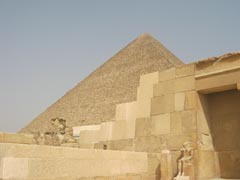 |
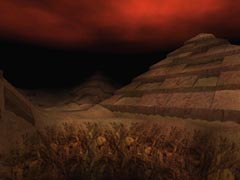 |
You can't even really attribute The Last Revelation's darkness with it being nighttime at this point. This is because the famous Pyramids Light Show takes place at night, a profoundly tasteful affair which I am sure Lara would have found enlightening. Perhaps the plagues and the beasts put a stop to that night's festivities?
Further liberties have been taken by Core with the location of the Temple of Horus. Although it makes perfect narrative sense to situate it in Giza amongst the imposing grandeur of the pyramids at the end of Lara's quest, in reality the Temple of Horus is at Edfu, a little south of the Valley of the Kings. It is a vast temple, many times bigger than Philae. The faces of the Gods and Goddesses on the reliefs which cover every surface inside the temple were chipped away long ago by Coptic Christians who saw them as heretical. Horus still looks on today.
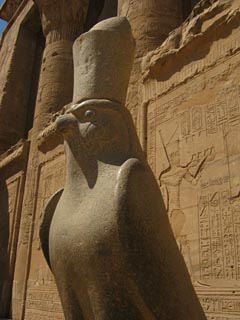 |
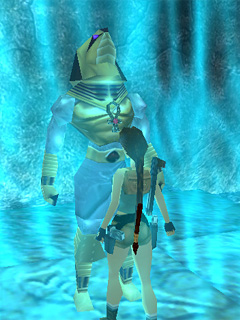 |
|
| A statue of Horus and the falcon-headed god's armor reanimated in The Last Revelation. | ||
In order to find Horus' temple, Lara must make her way inside the Great Pyramid, belonging to Khufu (or Cheops, as he is often known). Today, only 300 people are allowed inside the pyramid every day. Although possible erosion of the pyramids is a concern, this is mainly a precaution taken to prevent people fainting due to the humidity which forms in the pyramid. Besides, the access tunnel is so tiny that it is extremely difficult to pass anyone coming the other way. I was lucky enough to arrive in time for a ticket. Sadly, I have run out of superlatives, so I can't really express my awe.
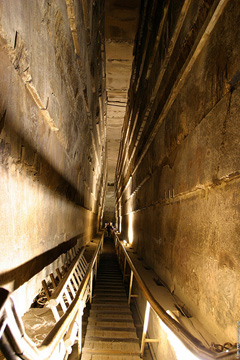 |
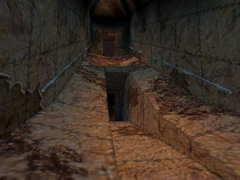 The grand gallery inside the Great Pyramid at Giza also appears in The Last Revelation. |
I won't spoil the ending of this magnificent game for those of you who haven't played it, but I will say that after all she'd been through, it might have been nice for Lara to catch a taxi back to Cairo at the end, check into the Rameses Hilton and pour herself a nice cool glass of Egypt's most famous beer.
And what is this beer called, you ask? Well, "Stella", of course!
Mary Goodden is on a quest to re-shape the landscape of video game journalism. You can find her thoughtful, entertaining and slightly irreverent commentary on games, literature and life at Well-Rendered.
Special thanks to Katie Fleming for the use of her Last Revelation screenshots. You can find more gorgeous game screens on Katie's Tomb Raider Site.
